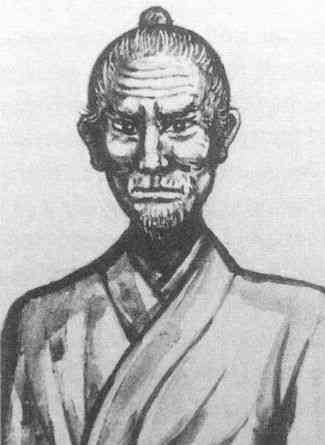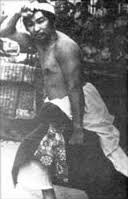 SOKON MATSAMURA
SOKON MATSAMURA
Matsumura Sōkon was one of the original karate masters of Okinawa. The years of his lifespan are reported variously as c.1809-1901 or 1798–1890 or 1809–1896 or 1800–1892. However, the dates on the plaque at Matsumura’s tomb, put there by Matsumura’s family, clearly state that he was born in 1809 and died in 1899.
Matsumura Sōkon was born in Yamagawa Village, Shuri, Okinawa. Matsumura began the study of karate under the guidance of Sakukawa Kanga. Sakukawa was an old man at the time and reluctant to teach the young Matsumura, who was regarded as something of a troublemaker. However, Sakukawa had promised Kaiyo Sōfuku, Matsumura Sōkon’s father, that he would teach the boy, and thus he did. Sakugawa began training him at Akata when he was 14 years old, in 1810. Some says that to train him to block, Sakugawa tied to him to a tree so he could not move. Then he threw punches at him. Matsumura spent 4 to 5 years studying under Sakukawa. As a young man, Matsumura had already garnered a reputation as an expert in the martial arts.
In 1832 he went to Satsuma, Japan, and stayed there for two years. While in Japan it is believed that he studied the Jigen Ryu style of swordsmanship. This is a very aggressive style practiced by the Satsuma samurai. His sensei in Jigen Ryu was a samurai by the name of Yashichiro Ijuin. It is perhaps at this time when Matsumura’s ideas about Bushido, the way of the warrior, and martial ethos were formed. He was the first to introduce the principles of Satsuma’s swordsmanship school, Jigen-ryū, into Ryūkyū kobujutsu (Ryūkyūan traditional martial arts) and he is credited with creating the foundation for the bōjutsu of Tsuken. He passed on Jigen-ryū to some of his students, including Ankō Asato and Itarashiki Chochu. The Tsuken Bō tradition was perfected by Tsuken Seisoku Ueekata of Shuri.
Matsumura was recruited into the service of the Shō family, the royal family of the Ryūkyū Kingdom in 1836 and received the title Shikudon (also Chikudun Pechin), a gentry rank. He began his career by serving the 17th King of Ryūkyū’s second Shō dynasty, King Shō Kō. In 1838 he married Yonamine Chiru, who was a martial arts expert as well. Matsumura eventually became the chief martial arts instructor and bodyguard for the Okinawan King Shō Kō. He subsequently served in this capacity for the last two Okinawan kings, Shō Iku and Shō Tai.
Matsumura traveled on behalf of the royal government to Fuzhou and Satsuma. He studied Ch’uan Fa in China as well as other martial arts. Around 1839 he went to China and studied the Shaolin style of Chinese boxing and weaponry. Legend has it that he actually
trained at the famed “Shoreiji” or Southern Shaolin Temple at this time. It is not known how long Matsumura remained in China but tradition has it that he stayed for some time.
It is also known that around 1860 Matsumura traveled to Foochow in Fukien Province, China, on a diplomatic mission for the Okinawan King. In the 1860’s he brought back the Chinese Kenpo Master Iwah and together they taught many Okinawans. He is also thought to have studied with the Chinese warrior Wai Shin Zan while in China. After his return from China he organized and refined Shuri-Te. His organizational efforts would eventually serve as the basis for the Shorin Ryu System of Okinawan Karate. Some authorities credit Matsumura with adopting the name “Shorin Ryu” while others say Anko Itosu (1830-1915), Matsumura’s student, is actually responsible for adopting this terminology. Shorin is the Japanese pronunciation of Shaolin. Even though this style is a blend of native Okinawan techniques and Chinese kenpo, it is named after the famed Shaolin Temple of China, renowned for its fighters.
Matsumura is credited with passing on the Shōrin-ryū Kempō-karate kata known as naihanchi (Tekki) I & II, passai (Bassai, Bassai Dai), seisan (Hangetsu), chintō, gojūshiho (Useishi), kusanku (Kanku Dai) {the embodiment of kusanku’steaching as passed on to Tode Sakugawa} and hakutsuru. The hakutsuru kata contains the elements of the Fujian White Crane system taught within the Shaolin system which was created by Fang Qiniang after destroying the gang who murdered her father Fang Zhonggong (Fang Shiyu). Lin Shixian was a Master of Black Crane and Eighteen Fist Monk Boxing. One of his Masters was Fang Zhonggong. He helped train Fang Quinang to defeat the gang who killed her father. Kwan Pang Yuiba (1828-1912) became master of Shaolin White Crane in the temple and supplanted Black Crane in 1837 as the official Temple Crane style, he was first student of Fāng Qīniáng.
Aunique feature of the Matsumura Shorin Ryu style is the teaching of the White Crane or Hakutsuru kata, although white crane techniques are woven throughout most of the kata of the
style and are especially evident in Gojushiho and Kusanku. However, the Hakutsuru kata is one of those elusive and esoteric kata of karate. According to the late Hohan Soken (1889-1982), the White Crane style was learned by Bushi Matsumura while he was in China. He brought the style back to Okinawa in the 1860’s. From then on, the system was a secret style only taught to immediate members of the Matsumura family. The White Crane style was passed on from Bushi Matsumura to Nabe Matsumura, his grandson, and then to Hohan Soken, Nabe’s nephew (Nabe’sister’s son). Hohan Soken did teach the White Crane to some members of the Ryu. These people were not family members but were a chosen few. Keep in mind the concept of a hereditary Ryu is a closed social nexus, like a family or a clan. Its membership is restricted to blood relatives, whereas a Kai or association is a group that practically anyone can get into, like a bowling league or a “self defense” studio. The family blood lineage of Matsumura Shorin Ryu seems to have been broken though and has become what is known as a Ryu Ha. It is known that Hohan Soken’s grandson now lives in New York City and has no interest in karate. The White Crane system is still in existence and being taught today, but it is rare and still underground.
The White Crane style is of Chinese origin and its techniques imitate the delicate movements of the crane or white heron. The Hakutsuru technique manifests the Chinese concept of the soft fist as opposed to the power-oriented native Okinawan techniques. The soft fist is
defensive and relies on speed and evasion as its primary tactic. Therefore the Matsumura family style has both the power oriented linear Okinawan technique as well as soft circular Chinese techniques. A perfect combination!
Actually there are a set of Hakutsuru kata handed down that are the jewel of the system. The more fundamental Hakutsuru Kata are sanchin-like training forms called Hakutsuru So & Ton. There is another one called Ryuken or dragon fist Sanchin. Finally there is the Matsumura No Hakutsuru Kata itself. The kata is taught in two forms, a sort of sho (minor) and dai (major) format. The sho version of the kata has the same embusen (pattern) as the dai version but it is simplistic in its techniques. The dai version of the Hakutsuru kata is very elaborate with many intricate hand techniques which make use of the wing (hane) of the crane. The wing is used in blocking to either trap, cover or repel a blow. Spearfinger thrusting to vital points is the main means of attack and counterattack taught within the framework of the kata as well. The Matsumura Hakutsuru kata also features a unique low level kicking sequence and its embusen relies on footwork from the Kusanku and Naihanchi kata. Its intricate and complex movements make the performance of the Matsumura No Hakutsuru kata unique among karate kata. It certainly deserves to be the secret kata of the Ryu. However, other versions of the Hakutsuru kata exist. These include Shito Ryu’s Hakucho, a fragment of the original kata, the Matayoshi version and the rare and beautiful
Kumemura Hakutsuru. This version is derived from Kume Village, a Chinese settlement which was a suburb of Naha and home of the Sanjuroku Seito, the thirty six families from Fukien Province, China. These families came from China with the purpose of enhancing the cultural and economic development of Okinawa. Although the transmission of Chinese martial arts to the Okinawans was also accomplished here.

Matsumura was given the title “bushi” meaning “warrior” by the Okinawan king in recognition of his abilities and accomplishments in the martial arts. Described by Gichin Funakoshi as a sensei with a terrifying presence, Matsumura was never defeated in a duel, though he fo ught many. Tall, thin, and possessing a pair of unsettling eyes, Matsumura was described by his student Ankō Itosu as blindingly fast and deceptively strong. His martial arts endeavors have been the progenitor of many contemporary karate styles: Shōrin-ryū, Shotokan, and Shitō-ryū, for example. Ultimately, all modern styles of karate that evolved from the Shuri-te lineage can be traced back to the teachings of Bushi Matsumura. Of note, his grandson was the modern Tōde master, Tsuyoshi Chitose, who assisted Gichin Funakoshi in the early introduction and teaching of karate in Japan and who founded the Chitō-ryū style.
Regarding the martial arts, Matsumura states that there are three main areas of understanding. The three areas are Gukushi No Bugei (martial arts of intelligence), Meimoko No Bugei (martial arts without self-control) and Budo No Bugei (true martial way). Gukushi No Bugei refers to having a technical knowledge of the martial arts but with no real substance. It is only a superficial understanding with no depth. He also makes a comment that i think is as relevant today as it was one hundred years ago when he wrote it. Matsumura said “a style is only as good as the man who practices”. Meimoko No Bugei refers to a person who has a physical understanding of the martial arts and can defeat other men. They are violent and dangerous and have no self control. Budo No Bugei refers to the true way of the warrior. In this true martial way, a person has the physical understanding of the martial arts and is powerful.
He has a strong sense of loyalty and would do nothing that is unnatural or contrary to nature. According to Matsumura, the true way of the warrior is characterized by seven virtues of Bu (military mind). They are as follows:
Bu prohibits violence.
Bu keeps discipline in soldiers.
Bu keeps control among the population.
Bu spreads virtue.
Bu gives a peaceful heart.
Bu helps keep peace between people.
Bu makes people or a nation prosperous.
MATSUMURA SHORIN RYU


